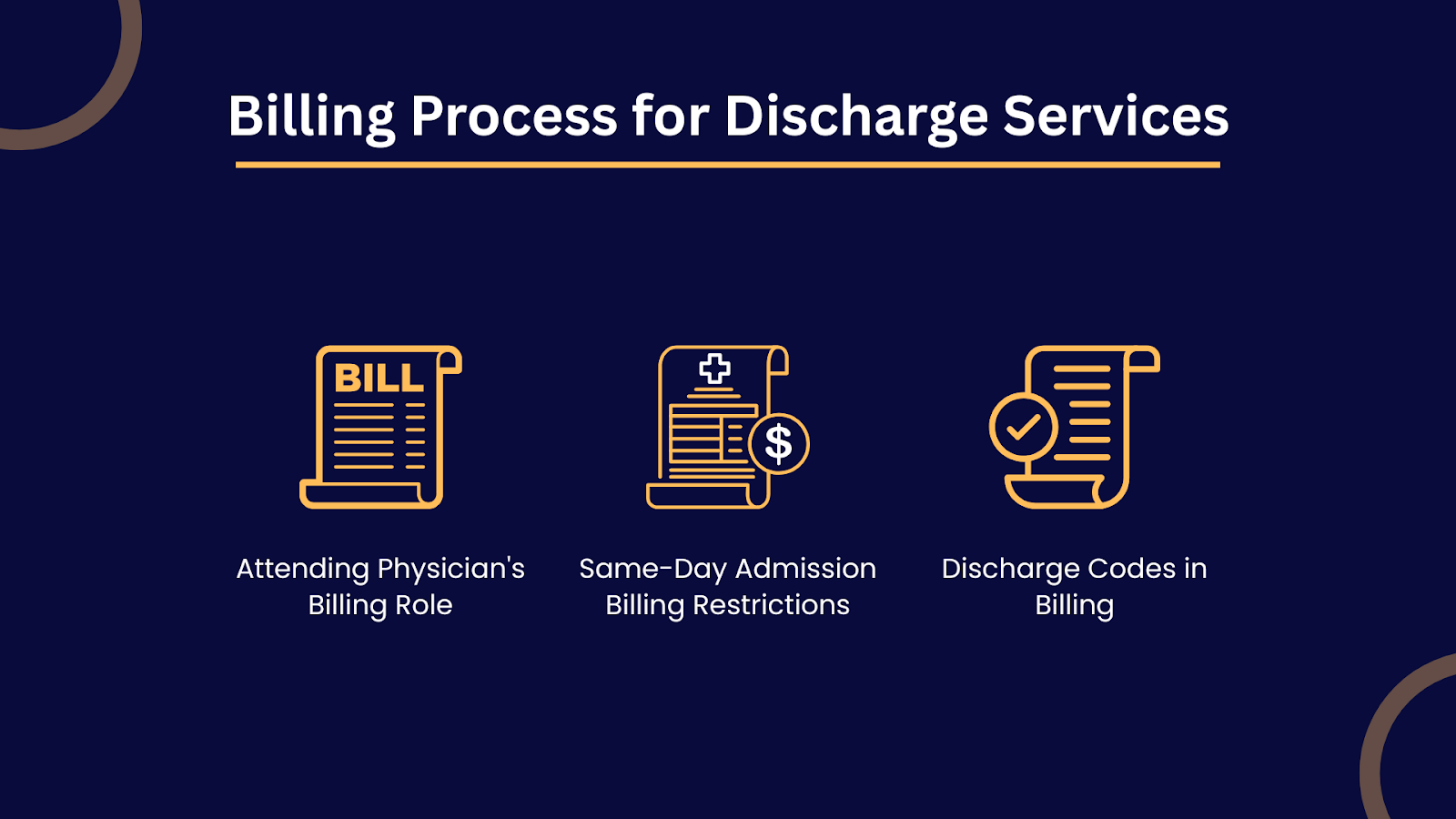Hospital billing can be complex, and one of the most challenging aspects is selecting the correct discharge CPT (Current Procedural Terminology) code. While it may seem straightforward, errors in this area can lead to claim denials, delayed payments, and compliance issues.
Nearly 11% of all hospital claims are denied, with some providers experiencing rejection rates as high as 30%. A large portion of these denials, 42%, are caused by coding errors, emphasizing the importance of accurate discharge coding.
This guide will help you understand the critical aspects of discharge CPT codes and offer practical solutions to ensure your hospital’s billing process remains efficient and accurate. Before selecting the correct discharge CPT code, let’s first understand what it is and why it matters in hospital billing.
What is the Discharge CPT Code?
At its core, a discharge CPT code is a specific code used to document the final services you provide to a patient during their discharge from the hospital. These codes reflect the time spent and the level of care you and your healthcare team provide during the discharge process. This process typically includes evaluating the patient’s condition, providing instructions for care at home, and preparing discharge documentation.
Discharge CPT codes are essential because they directly affect the financial reimbursement for the services you provided. Without accurate discharge coding, your hospital may face reimbursement discrepancies or even claim rejections from insurance companies.
Also Read: What is Medical Coding? A Comprehensive Guide
Common Discharge CPT Codes
There are several CPT codes used in hospitals to report a patient’s discharge accurately. Some of the most frequently used discharge codes include 99238 and 99239.
- CPT Code 99238: This code is used for a short hospital discharge. It typically covers the discharge of a patient who has been admitted to the hospital for less than 30 minutes. In this case, the patient may be discharged after receiving a brief evaluation and medical care.
- CPT Code 99239: This code is used for a longer discharge process, where the patient’s discharge includes additional care or time spent during the discharge process. For instance, if the patient requires more extensive instructions, follow-up care, or coordination of services after discharge, this code is used. It is typically associated with discharges that involve a more thorough review of the patient’s condition and necessary post-discharge care.
Now that we understand what discharge CPT codes are, let’s explore the exact process of selecting the correct code based on the patient’s discharge time and complexity.
Criteria for Selecting the Appropriate Discharge Code
Choosing the correct discharge CPT code depends on several factors, including the patient’s condition, the length of stay, and the complexity of care provided during the discharge process.
Here’s a breakdown of the criteria for selecting the appropriate discharge code:

1. Length of Stay:
The length of time the patient has been in the hospital is a key factor. For shorter stays, a simpler discharge code, such as 99238, may be used. For more extended stays or more complex discharges, the more detailed 99239 code may be necessary.
2. Patient Condition:
The patient’s condition at the time of discharge also plays a role in determining which code is appropriate. For example, if the patient requires more involved follow-up care or discharge instructions, a more complex discharge code, such as 99239, may be selected. On the other hand, if the patient is being discharged with minimal post-care requirements, a simpler code, such as 99238, may suffice.
3. Complexity of the Discharge Process:
If the discharge involves discussions about medications, follow-up appointments, or the need for extensive care coordination, the 99239 code is likely the best choice. However, if the patient is discharged with fewer instructions and no complications, the 99238 code may be used.
Additional Related Codes
In addition to 99238 and 99239, there are other discharge-related codes used for specific situations:
CPT Code 99217: This code is used for observation care discharges, typically when a patient is admitted under observation status and discharged the same day. This can happen if a patient is being monitored for a short period to determine if they need further treatment or hospitalization, but is ultimately discharged after a brief stay.
When to Use CPT Code 99217?
If a patient is admitted to the hospital under observation status, stays for a few hours or overnight, and is then discharged the same day without requiring additional treatments, CPT Code 99217 would be the appropriate code. It is essential to understand that this code does not apply to full admissions or discharges after extended hospital stays.
As we have seen, documentation plays a crucial role in accurately selecting discharge codes. Let’s now examine how documentation impacts the selection and billing process.
Documentation Requirements for Discharge CPT Codes
Proper documentation is required to avoid billing issues and ensure that you’re paid for the care provided. Here are some key requirements:
1. Detailed Time Documentation for CPT 99239
For code 99239, it’s essential to document the exact time spent with the patient during discharge. It’s not enough to simply note that discharge was completed; you must break down the activities involved and the time allocated to each. If the discharge took longer than 30 minutes, this must be clearly stated to justify the use of 99239 over 99238.
Example
The discharge process took 45 minutes, including 10 minutes for reviewing the patient’s hospital stay, 15 minutes for explaining follow-up care instructions, and 20 minutes to discuss medication management and recovery plans.
2. Proper Completion of Discharge Forms
It’s not just about the time. Every discharge-related form needs to be fully completed to prevent billing delays or denials. This includes:
- Discharge Summaries: A detailed summary that includes the reason for hospitalization, treatments provided, outcomes, and any follow-up care instructions.
- Follow-Up Care Instructions: Clear and concise instructions for post-discharge care, including medication regimens, follow-up visits, or referrals to specialists. Ensure that these instructions are signed and dated by the attending physician.
- Other Relevant Documentation: This could include any other forms that capture patient-specific information relevant to their recovery process, such as home health care plans, physical therapy instructions, or emergency contact details for follow-up support.
Example:
The discharge form was completed, including detailed instructions for follow-up care with the cardiology team, a prescription for blood pressure medication, and contact information for after-hours assistance.
3. Medical Necessity and Complexity Documentation
If the discharge involved complex decision-making or required a thorough review of the patient’s condition, it’s essential to document the medical necessity of the actions taken.
Example:
If a prolonged discussion about a patient’s treatment or a comprehensive review of medications was involved, be sure to note it in your records. The more specific the documentation, the more accurately it can justify the complexity of the discharge.
By meticulously documenting the time spent and the activities involved in the discharge process, you not only ensure accurate billing but also protect against audits and claim denials. Let’s now explore the broader billing process for discharge services, which involves several key considerations.
Billing Process for Discharge Services
Discharge services are part of the broader billing cycle in hospitals, and several key considerations must be made:

1. The role of the Attending Physician in Billing
The attending physician plays a crucial role in ensuring that all discharge-related services are accurately documented. They must verify the time spent and ensure that the discharge code used corresponds to the services provided.
2. Restrictions on Billing for Discharge and Admission on the Same Day
Hospitals cannot bill for both a discharge and an admission on the same day using the same codes. If a patient is admitted and discharged on the same day, separate codes must be used for each process, ensuring that the discharge code reflects the services provided and the time spent.
3. How Discharge Codes Fit into the Broader Billing Cycle
The discharge CPT code is one part of the larger billing cycle, which also includes admission, diagnosis, and treatment codes. When the discharge code is accurately selected and documented, it streamlines the overall billing process and helps ensure reimbursement.
The discharge CPT code is part of a larger billing cycle that includes admission, diagnosis, and treatment codes. Properly selecting and documenting the discharge code helps streamline the billing process and ensure timely reimbursement. ProMantra can help facilitate this process by automating key steps in revenue cycle management, minimizing errors, and ensuring accuracy throughout the billing cycle.
However, there are still several challenges that hospitalists face in discharge coding. Let’s take a closer look at these challenges and how to overcome them to avoid any hurdles.
Common Challenges Faced by Hospitalists in Understanding Discharge Codes
Hospitalists often face several challenges when it comes to discharge coding. These challenges can lead to delays in billing, rejected claims, and even potential compliance issues. Let’s explore these everyday struggles and how healthcare providers can overcome them.
1. Time Management
Accurately tracking the time spent on discharge activities, especially in busy hospital settings, can be challenging. Hospitalists may forget to document exact times or may be uncertain about how to classify the complexity of a discharge. Time management is critical in discharge coding, as it directly impacts the accuracy of the chosen CPT code.
2. Complex Documentation
Discharge coding requires detailed documentation, which can be overwhelming for hospitalists who are already managing many patients and other responsibilities. Ensuring that all the necessary information is captured can be a daunting task, especially when the discharge process involves multiple activities, such as follow-up care instructions, final examinations, and medication discussions.
3. Understanding the Guidelines
Discharge codes like 99238 and 99239 have specific guidelines regarding the duration and complexity of discharge services. Hospitalists may struggle with determining which code is appropriate, especially when the discharge involves multiple activities that may not fit neatly into one category. The guidelines for discharge coding can sometimes be unclear, leading to confusion and the selection of an incorrect code.
To address these challenges, healthcare providers can rely on comprehensive solutions that simplify discharge coding. ProMantra offers a robust platform designed to streamline the process and ensure accurate, efficient coding:
- Automated Time Tracking and Documentation: Promantra’s automated time-tracking feature ensures accurate documentation of discharge activities, eliminating the risk of missing or incorrect time logs.
- Streamlined Documentation with Templates: ProMantra provides customizable templates to simplify documentation. These templates capture all necessary details, from patient conditions to follow-up care instructions, preventing errors and omissions.
- Smart Coding Assistance: ProMantra offers real-time coding suggestions based on discharge details, ensuring the correct CPT code is selected and reducing the risk of coding mistakes.
By using Promantra, hospitals can eliminate many of the challenges associated with discharge coding, allowing hospitalists to focus on delivering the best care possible while ensuring an accurate and efficient billing process.
Conclusion
Accurately selecting and documenting discharge CPT codes is crucial for correct reimbursement. By following guidelines and using the right tools, healthcare providers can reduce billing errors and improve operations.
ProMantra simplifies this process with automated time tracking, reducing the risk of missed documentation and improving billing accuracy. Additionally, smart coding assistance offers real-time suggestions to help select the correct discharge code based on the patient’s discharge details.
To enhance your discharge coding accuracy and optimize your billing cycle, request a demo today at ProMantra and see how our platform can make a difference in your hospital operations.




